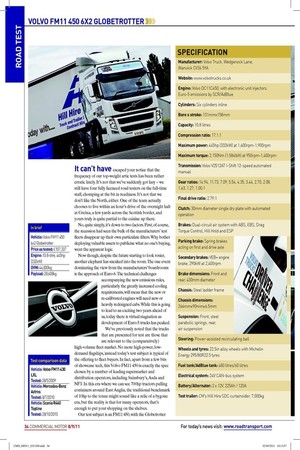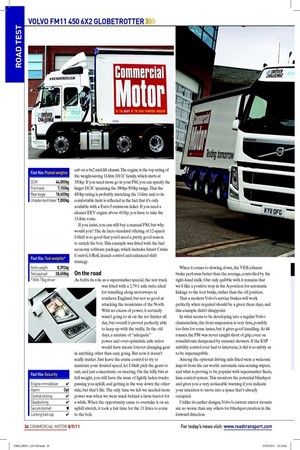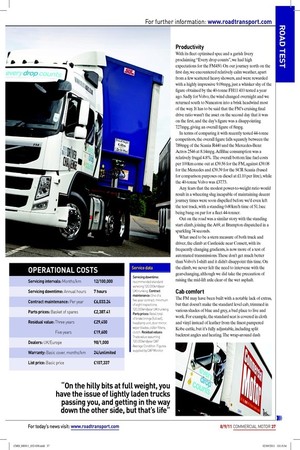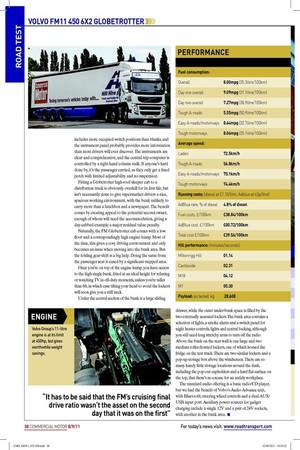It can’t have escaped your notice that the frequency of
Page 27

Page 29

Page 30

Page 31

If you've noticed an error in this article please click here to report it so we can fix it.
our top-weight artic tests has been rather erratic lately. It’s not that we’ve suddenly got lazy – we still have four fully licenced road testers on the full-time staff, chomping at the bit in readiness. It’s not that we don’t like the North, either. One of the team actually chooses to live within an hour’s drive of the overnight halt at Gretna, a few yards across the Scottish border, and yours truly is quite partial to the cuisine up there.
No, quite simply, it’s down to two factors. First, of course, the recession had seen the bulk of the manufacturers’ test leets disappear up their own particulate ilters. Why bother deploying valuable assets to publicise what no one’s buying, went the apparent logic.
Now though, despite the future starting to look rosier, another elephant has sneaked into the room. The one event dominating the view from the manufacturers’ boardrooms is the approach of Euro-6. The technical challenges accompanying the new emissions rules, particularly the greatly increased cooling requirements, will mean that the new or re-calibrated engines will need new or heavily redesigned cabs. While this is going to lead to an exciting two years ahead of us, today there is virtual stagnation as development of Euro-5 trucks has peaked.
We’ve previously noted that the trucks that are presented for test are those that are relevant to the (comparatively) high-volume leet market. No more high-power, lowdemand lagships, instead today’s test subject is typical of the offering to leet buyers. In fact, apart from a few bits of showcase tech, this Volvo FM11 450 is exactly the spec chosen by a number of leading supermarket and distribution operators, including Sainsbury’s, Asda and NFT. In this era where we can see 700hp tractors pulling containers around East Anglia, the traditional benchmark of 10hp to the tonne might sound like a relic of a bygone era, but the reality is that for many operators, that’s enough to put your shopping on the shelves.
Our test subject is an FM11 450, with the Globetrotter cab on a 6x2 mid-lift chassis. The engine is the top rating of the weight-saving 11-litre D11C family, which starts at 330hp. If you need more go in your FM, you can specify the larger D13C spanning the 380hp-500hp range. That the 450hp rating is probably stretching the 11-litre unit to its comfortable limit is relected in the fact that it’s only available with a Euro-5 emissions ticket. If you need a cleaner EEV engine above 410hp, you have to take the 13-litre route.
If you insist, you can still buy a manual FM, but why would you? The de facto standard offering of 12-speed I-Shift is so good that you’d need a pretty good reason to untick the box. This example was itted with the fuel economy software package, which includes Smart Cruise Control, I-Roll, launch control and enhanced shift strategy.
On the road
As beits its role as a supermarket special, the test truck was itted with a 2.79:1 axle ratio, ideal for trundling along motorways in southern England, but not so good at attacking the mountains of the North. With no excess of power, it certainly wasn’t going to sit on the rev limiter all day, but overall it proved perfectly able to keep up with the trafic. In the old days, a mixture of “adequate” power and over-optimistic axle ratios would have meant forever changing gear in anything other than easy going. But now it doesn’t really matter. Just leave the cruise control to try to maintain your desired speed, let I-Shift pick the gears to suit, and just concentrate on steering. On the hilly bits at full weight, you still have the issue of lightly laden trucks passing you uphill, and getting in the way down the other side, but that’s life. The only time we felt we needed more power was when we were stuck behind a farm tractor for a while. When the opportunity came to overtake it on an uphill stretch, it took a fair time for the 11 litres to come to the boil. When it comes to slowing down, the VEB exhaust brake performs better than the average, controlled by the right-hand stalk. Our only quibble with it remains that we’d like a positive stop in the A-position for automatic linkage to the foot brake, rather than the off position.
That a modern Volvo’s service brakes will work perfectly when required should be a given these days, and this example didn’t disappoint.
In what seems to be developing into a regular Volvo characteristic, the front suspension is very irm, possibly too irm for some tastes, but it gives good handling. At 44 tonnes, the FM was never caught short of grip, even on roundabouts dampened by summer showers. If the ESP stability control ever had to intervene, it did it so subtly as to be imperceptible.
Among the optional driving aids itted were a welcome import from the car world: automatic rain-sensing wipers, and what is proving to be popular with supermarket leets, lane control system. This monitors the potential blindspot and gives you a very noticeable warning if you indicate your intention to move into a space that’s already occupied.
Unlike its earlier designs, Volvo’s current mirror mounts are no worse than any others for blindspot creation in the forward direction.
Productivity
With its leet optimised spec and a garish livery proclaiming “Every drop counts”, we had high expectations for the FM450. On our journey north on the irst day, we encountered relatively calm weather, apart from a few scattered heavy showers, and were rewarded with a highly impressive 9.09mpg, just a whisker shy of the igure obtained by the 40-tonne FH11 410 tested a year ago. Sadly for Volvo, the wind changed overnight and we returned south to Nuneaton into a brisk headwind most of the way. It has to be said that the FM’s cruising inal drive ratio wasn’t the asset on the second day that it was on the irst, and the day’s igure was a disappointing 7.27mpg, giving an overall igure of 8mpg.
In terms of comparing it with recently tested 44-tonne competitors, the overall igure falls squarely between the 7.89mpg of the Scania R440 and the Mercedes-Benz Actros 2546 at 8.14mpg. AdBlue consumption was a relatively frugal 4.8%. The overall bottom line fuel costs per 100km come out at £39.56 for the FM, against £39.08 for the Mercedes and £39.39 for the SCR Scania (based for comparison purposes on diesel at £1.10 per litre), while the 40-tonne Volvo was £37.73.
Any fears that the modest power-to-weight ratio would result in a wheezing slug incapable of maintaining decent journey times were soon dispelled before we’d even left the test track, with a standing 0-80km/h time of 51.1sec being bang on par for a leet 44-tonner.
Out on the road was a similar story with the standing start climb, joining the A69, at Brampton dispatched in a sparkling 74 seconds.
What used to be a stern measure of both truck and driver, the climb at Castleside near Consett, with its frequently changing gradients, is now more of a test of automated transmissions. These don’t get much better than Volvo’s I-shift and it didn’t disappoint this time. On the climb, we never felt the need to intervene with the gear-changing, although we did take the precaution of raising the mid-lift axle clear of the wet asphalt.
Cab comfort
The FM may have been built with a notable lack of extras, but that doesn’t make the standard level cab, trimmed in various shades of blue and grey, a bad place to live and work. For example, the standard seat is covered in cloth and vinyl instead of leather from the inest pampered Kobe cattle, but it’s fully adjustable, including split backrest angles and heating. The wrap-around dash includes more occupied switch positions than blanks, and the instrument panel probably provides more information than most drivers will ever discover. The instruments are clear and comprehensive, and the central trip computer is controlled by a right-hand column stalk. If anyone’s hard done by, it’s the passenger carried, as they only get a ixed perch with limited adjustability and no suspension.
Fitting a Globetrotter high-roof sleeper cab to a distribution truck is obviously overkill for its irst life, but isn’t necessarily done to give supermarket drivers a nice, spacious working environment, with the bunk unlikely to carry more than a lunchbox and a newspaper. The beneit comes by creating appeal to the potential second owner, enough of whom will need the accommodation, giving a day-cabbed example a major residual value penalty.
Naturally, the FM Globetrotter cab comes with a low loor and a correspondingly high engine hump. Most of the time, this gives a cosy driving environment and only becomes an issue when moving into the bunk area. But the folding gear shift is a big help. Doing the same from the passenger seat is eased by a signiicant stepped area.
Once you’re on top of the engine hump, you have access to the high single bunk, itted at an ideal height for relaxing or watching TV in off-duty moments, unless you’re taller than 6ft, in which case tilting your head to avoid the lockers will soon give you a stiff neck.
Under the central section of the bunk is a large sliding drawer, while the outer under-bunk space is illed by the two externally accessed lockers. The bunk area contains a selection of lights, a smoke alarm and a switch panel for night heater controls, lights and central locking, although you still need long stretchy arms to turn off the radio. Above the bunk on the rear wall is one large and two medium roller-fronted lockers, one of which housed the fridge on the test truck. There are two similar lockers and a pop-up storage box above the windscreen. There are so many handy little storage locations around the dash, including the pop-out cupholders and a hard lat surface on the top, that there’s no excuse for an untidy workplace.
The standard audio offering is a basic radio/CD player, but we had the beneit of Volvo’s Audio Advance unit, with Bluetooth, steering wheel controls and a dual AUX/ USB input port. Auxiliary power sources for gadget charging include a single 12V and a pair of 24V sockets, with another in the bunk area. ■












































